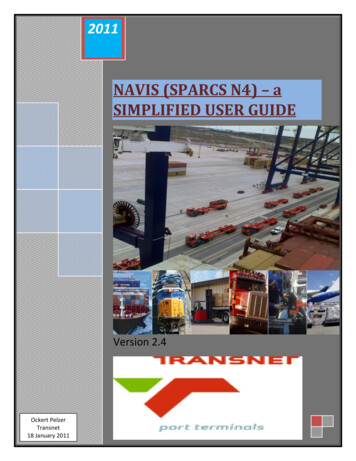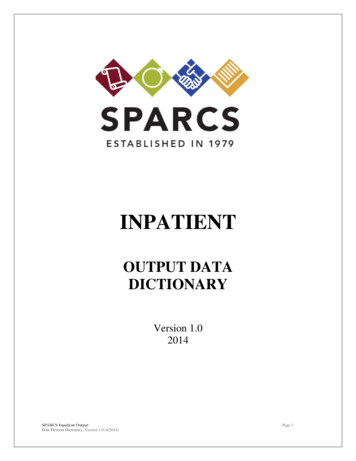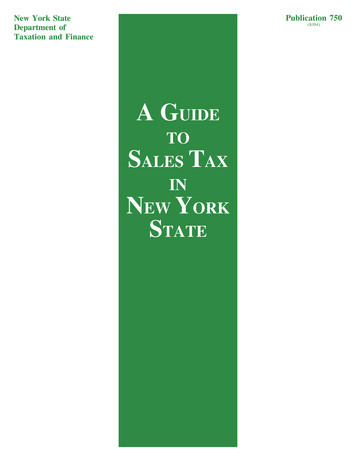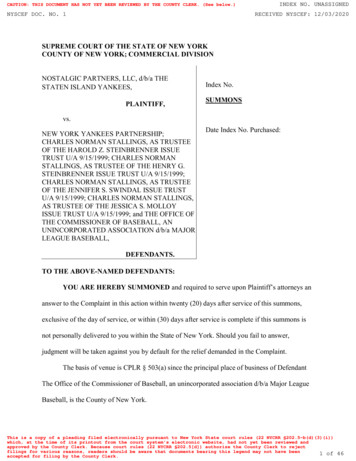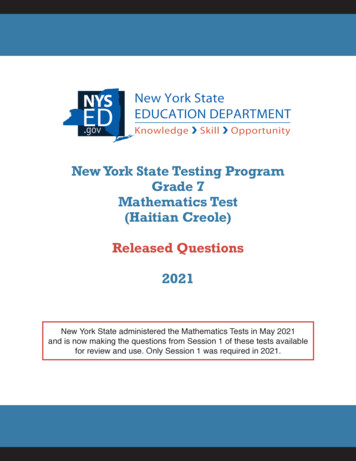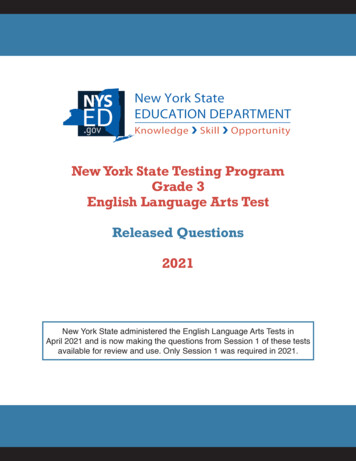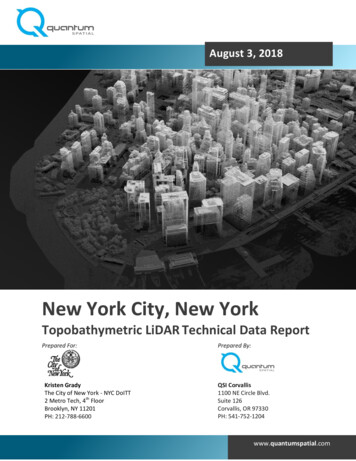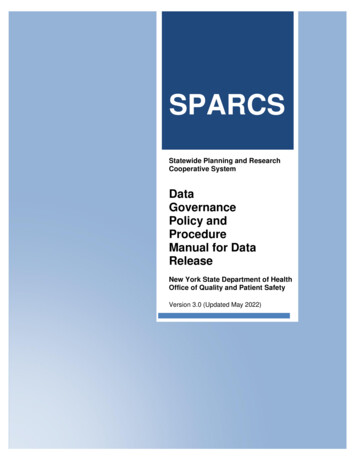
Transcription
New York State Department of HealthOffice of Quality and Patient SafetySPARCS Data GovernancePolicy and Procedure ManualSPARCSStatewide Planning and ResearchCooperative SystemDataGovernancePolicy andProcedureManual for DataReleaseNew York State Department of HealthOffice of Quality and Patient SafetyVersion 3.0 (Updated May 2022)
New York State Department of HealthOffice of Quality and Patient SafetySPARCS Data GovernancePolicy and Procedure ManualINTRODUCTION . 2SPARCS DATA ACCESS . 2SPARCS DATA FILE TYPES . 2De-identified (Public Use Files) . 3Limited Data . 3Data Years Available . 3Data Extraction Options . 3Mortality Indicator Request . 3Requesting Limited Data File(s) . 4Review Process . 4Identifiable Data . 5Data Years Available . 5Requesting Identifiable Data Element Categories . 5Data Extraction Options . 6Mortality Indicator Requests.6Linking Patient Level Data Requests . 6Abortion and HIV/AIDS Data Requests . 6IRB Review. 7Requesting Identifiable Data File(s) . 7Identifiable Data File: Review Process . 7SPARCS Data Governance Committee & Meetings . 8Pre-Meeting Activities . 8During the Meeting . 8Post-Meeting Activities . 9DATA SECURITY . 9APPROVED APPLICATION ACTIONS . 9Amendments to Applications . 9ADMINISTRATIVE ACTIONS . 10DATA RETENTION/APPLICATION EXPIRATION DATE . 10Extension of Data Retention/Application Expiration Date Requests. 10DATA DELIVERY AND FEES . 10PUBLICATION REQUIREMENTS . 11CONTACT INFORMATION . 11GLOSSARY OF TERMS . 12ATTACHMENT A: Review and Recommendations Document13Version 3.0 (May 2022)Page 1
New York State Department of HealthOffice of Quality and Patient SafetySPARCS Data GovernancePolicy and Procedure ManualINTRODUCTIONThe Statewide Planning and Research Cooperative System (SPARCS) is a comprehensive all-payer data collection systemestablished in 1979 as a result of cooperation between the healthcare industry and state government. The system wasinitially created to collect information on discharges from hospitals. SPARCS currently collects patient-level details onpatient characteristics, diagnoses and treatments, services, and charges for inpatient and outpatient services (ambulatorysurgery, emergency department, and outpatient services).The enabling legislation for SPARCS is Section 2816 of the New York State Public Health Law (PHL). The regulationspertaining to SPARCS data and the SPARCS program are located in Section 400.18 of Title 10 (Health) of the OfficialCompilation of Codes, Rules, and Regulations of the State of New York (NYCRR).The SPARCS Data Governance Committee (DGC) was established in September 2014 to review identifiable datarequests and make approval recommendations to the New York State Commissioner of Health (“Commissioner”). TheDGC is the successor to the SPARCS Data Protection Review Board (DPRB), which reviewed identifiable data requestsprior to 2014. All previously approved DPRB data requests were grandfathered in under the new governance structure.The SPARCS program is responsible for ensuring the quality, consistency, usability, security, and availability of all datarequests from internal and external stakeholders seeking to use SPARCS data. The SPARCS program follows allapplicable federal and state laws when determining whether SPARCS data that contain identifiable data elements may beshared and whether a disclosure of SPARCS constitutes an unwarranted invasion of personal privacy.The SPARCS program supports open government initiatives and transparency while continuing to assureconfidentiality and security of the patient data it is charged with protecting. The SPARCS program publishes a list ofall projects since 2009 that have been approved to use identifiable data. This list includes the name of the projectdirector, the organization, and the title of the project.SPARCS DATA ACCESSPer regulation, SPARCS data may be used for: (1) medical or scientific research; (2) statistical or epidemiological purposes; or(3) other proper purposes as determined by the Commissioner. All entities seeking SPARCS identifiable or limited data mustsubmit a request to the SPARCS program using the standard data request form. This manual contains detailed informationabout SPARCS data access, including the types of data available and the process for review and approval of data requests. Indetermining the purpose of a request for SPARCS data, the SPARCS program is not limited to information contained in thedata request form and may request supplemental information from the applicant. The Commissioner may rescind for cause, atany time, the approval of a data request.SPARCS DATA FILE TYPESThere are three types of SPARCS data available to researchers and others interested in using the data for authorizedpurposes:1.2.3.De-identified (Public Use) data filesLimited data fileIdentifiable data fileThe Data Governance Committee is responsible for the review and approval of Identifiable data file requests. Limited datafile requests are reviewed and processed by qualified SPARCS program staff and approved by the SPARCS Administrator.De-identified (“Public Use”) data files are available to the public on the Department’s open data platform. This sectiondescribes the contents and uses of each file type as well as procedures for accessing the data.Version 3.0 (May 2022)Page 2
New York State Department of HealthOffice of Quality and Patient SafetySPARCS Data GovernancePolicy and Procedure ManualDE-IDENTIFIED (PUBLIC USE) DATA FILESPublic Use files do not contain personally identifiable information (PII) or protected health information (PHI). DetailedPublic Use data files can be accessed easily and free of charge on Health Data New York, the Department’s open dataplatform. There are no restrictions on the use of public use files. Many SPARCS discharge public use data files aresummarized in aggregate statistical tables by calendar year, with tables grouped at the state, county, and hospitallevels. A calendar year inpatient discharge record-level detail file is also published annually (2009 to current). PublicUse data files are a rich resource for researchers and entities trying to understand how their research questions can beanswered using SPARCS data. Prior to requesting limited or identifiable data files, applicants should review the publicuse data to determine if public use files can meet their research needs.LIMITED DATA FILESThe SPARCS program applies applicable New York State standards and many of the standards set forth in the HealthInsurance Portability and Accountability Act of 1996 (HIPAA) (P.L. 104-191) and implemented regulations (“the PrivacyRule”) when providing data to approved requestors. SPARCS Limited data files follow the redaction policies accordingto many of the specifications for limited data listed at 45 CFR Section 164.514(e), but Limited data files still contain PHIand indirect identifiers that requires data requestors to sign a data use agreement. A complete list of data elements andvalues available in a limited data file can be found in the SPARCS Data Dictionary.DATA YEARS AVAILABLESPARCS Inpatient and Outpatient limited data files are currently available for the following years: Inpatient (1982-present) OutpatientoAmbulatory Surgery (1983-present)oEmergency Department (2005-present)oExpanded Outpatient Data Collection (EODC) (2011-present)SPARCS data is requested by calendar year for a predetermined time. An applicant can request up to three (3) years beyondthe current calendar year. Review the SPARCS data request application Instructions and SPARCS Data Dictionary foradditional information on the available data.DATA EXTRACTION OPTIONSSome proposed uses of SPARCS data may be achievable without sending the entire statewide data file(s) for the yearsrequested. In those cases, the SPARCS program can extract specific subsets of the statewide data based on appropriatecriteria. Extraction criteria may be proposed by the applicant or by the DGC or SPARCS Administrator during the reviewprocess. Data extractions support the SPARCS program policy of providing the minimum data necessary to complete theapproved project. The following extraction criteria are currently available: Claim Type (IP only, ED only, or OP only) Patient County of Residence Hospital County Age Gender Hospital Permanent Facility Identifier (PFI)MORTALITY INDICATOR REQUESTSThe Mortality Indicator is an additional data element that can be appended to limited data if requested and approved bythe SPARCS program. The Mortality Indicator connects to the limited data file via the Claim Trans ID. This optionVersion 3.0 (May 2022)Page 3
New York State Department of HealthOffice of Quality and Patient SafetySPARCS Data GovernancePolicy and Procedure Manualprovides researchers with indication of death to facilitate patient outcomes research. Mortality Indicators further supportthe SPARCS program in adhering to its minimum use necessary policy. Applicants must provide a justificationexplaining why mortality indicators are required for the proposed project. Mortality indicators identify whether thepatient’s disposition is deceased at 7 15 30 180 360 days post admission date and 7 15 30 180 360 days postdischarge date. Mortality indicators are created by NYSDOH and are available for data files from 2005 to present.REQUESTING LIMITED DATA FILE(S)To request a SPARCS limited data file, review the Instructions, complete the SPARCS Limited and Identifiable DataRequest Form (DOH-5132) and supporting documents, and send the completed request package to:sparcs.requests@health.ny.gov. The forms listed below must be submitted and deemed complete for every limiteddata request and are available at: . SPARCS Limited and Identifiable Data Request Form (DOH-5132)This form must be signed by the Project Director and a representative with the authority to legally bind theorganization to the terms of the application. Organizational Data Use AgreementThis form must be signed by a representative with the authority to legally bind the organization to the terms of theagreement. Individual Data Use Agreement(s)Individual Data Use Agreements (DUAs) must be signed by the Project Director and by each person that will useSPARCS data. Security GuidelinesThis form must be reviewed and signed by the requesting organization’s Chief Information Security Officeror lead Information Technology administrator.REVIEW PROCESSLimited data file requests are reviewed by qualified SPARCS program staff and approved by the SPARCSAdministrator; DGC approval and ratification by the Commissioner or Commissioner’s designee are not required.SPARCS staff review the application and supporting documents for completeness and the following are verified: that the project adheres to approved SPARCS regulation data uses; the feasibility and soundness of the proposed project; credentials and qualifications of the applicant(s) to undertake the research; proposed research methodology; sufficiency of security and data protection protocols; appropriateness of publication and/or data dissemination plans; and appropriateness of data linkage plans, if any.After the initial review, the SPARCS program provides the applicant with a list of questions and requested revisions, ifany. This review process often requires multiple rounds of correspondence and revision. It is intended to ensure that allrequests contain sufficient information for the SPARCS Administrator to make an informed decision regardingapproval.Note: The timing of an organizational representative’s signature of the application is at the applicant’s discretion.However, if changes are required after the initial submission as described above, organizational representativeswill need to sign the materials again. As a result, it is recommended that applicants obtain an organizationalrepresentative’s signature as a final step in the application process after all required revisions have beencompleted.If the request is approved, the SPARCS program sends the applicant an approval letter describing the data files andyears to be provided and an expiration date of the application. If applicable, an invoice for the data is sent, and uponVersion 3.0 (May 2022)Page 4
New York State Department of HealthOffice of Quality and Patient SafetySPARCS Data GovernancePolicy and Procedure Manualreceipt of payment the data is transferred within 30 business days using a mutually agreed-upon secure file transferprotocol (SFTP). While DGC review is not required, approval of requests for limited data files is not guaranteed.Applicants may be required to revise or amend submitted materials during the review process to bring the request intoalignment with applicable laws, regulations, and SPARCS program policy.IDENTIFIABLE DATA FILE(S)An identifiable SPARCS data file contains data elements which constitute PHI and PII and which could be used to directly reidentify individual patients if improperly disclosed. Due to the sensitive nature of this information, requests for access toidentifiable data files are subject to the review and approval procedures described at 10 NYCRR Section 400.18, includingapproval by the DGC and ratification by the Commissioner or Commissioner’s designee. Identifiable data file applications mustbe deemed complete and satisfy all applicable SPARCS program policy requirements before being presented the DGC.DATA YEARS AVAILABLESPARCS Inpatient and Outpatient identifiable data files are currently available for the following years: Inpatient (1982-present) Outpatient:oAmbulatory Surgery (1983-present)oEmergency Department (2005-present)oExpanded Outpatient Data Collection (EODC) (2011-present)SPARCS data is requested by calendar year for a predetermined time. An applicant can request up to three (3) years beyondthe current calendar year of the application submission year. Review the SPARCS data request application Instructions andSPARCS Data Dictionary for additional information on the available data.REQUESTING IDENTIFIABLE DATA ELEMENT CATEGORIESThe SPARCS Limited and Identifiable Data Request Form requires applicants to provide a justification explaining why therequested identifiable data element categories are needed for the proposed research and how the data elements will beused during the project. If approved for a category of identifiable data elements, applicants receive all elements in thatcategory. Your justification must include the specific data elements from the category you intend to use. Some identifiabledata elements may not be available for all years requested. Refer to the SPARCS Data Dictionary for information on dataelements and years available. An additional charge applies per identifiable category per year requested and approved forrelease by the DGC. Table 1 lists the identifiable data element categories that can be requested and the associated dataelements within those categories.Table 1. Identifiable Data Element Categories Available for RequestDatesDate of BirthPatient Address Patient Birth Patient StreetAccident-Related DateAdmission DateDischarge DateStatement from DateStatement Thru DateProcedure DateDate of ServiceOccurrence DateOccurrence Span fromDate Occurrence Span ThruDateDateAddress Line 1 Patient StreetAddress Line 2 Patient Zip CodeExtension Subscriber Zip CodePatient RecordNumber Medical RecordNumber Mother’s MedicalRecord Number (fornewborn) Patient ControlNumber Previous PatientControl NumberPolicy Numbers Subscriber GroupNumber Member IdentificationNumber Service Provider Version 3.0 (May 2022)EmployerIdentification NumberInsurance PolicyNumberSubscriber GroupNumberSubscriber GroupNameSubscriber MemberIdentification NumberPage 5
New York State Department of HealthOffice of Quality and Patient SafetySPARCS Data GovernancePolicy and Procedure ManualDATA EXTRACTION OPTIONSSome proposed uses of SPARCS data may be achievable without sending the entire statewide data file(s) for the yearsrequested. In those cases, the SPARCS program can extract specific subsets of the statewide data based on appropriatecriteria. Extraction criteria may be proposed by the applicant or by the DGC or SPARCS Administrator during the reviewprocess. Data extractions support the SPARCS program policy of providing the minimum data necessary to complete theapproved project. The following extraction criteria are currently available: Claim Type (IP only, ED only, or OP only) Patient County of Residence Hospital County Age Gender Hospital Permanent Facility Identifier (PFI)MORTALITY INDICATOR REQUESTSThe Mortality Indicator is an additional data element that can be appended to an identifiable data file(s) if requestedand approved by the DGC. The Mortality Indicator connects to the identifiable data file via the Claim Trans ID. Thisoption provides researchers with indication of death to facilitate patient outcomes research. Mortality Indicators furthersupport the SPARCS program in adhering to its minimum use necessary policy. Applicants must provide a justificationexplaining why mortality indicators are required for the proposed project. Mortality indicators identify whether thepatient’s disposition is deceased at 7 15 30 180 360 days post admission date and 7 15 30 180 360 days postdischarge date. There is an additional charge for appending mortality indicators to the approved data file(s). Mortalityindicators are created by NYSDOH and are available for data files from 2005 to present.LINKING PATIENT LEVEL DATA REQUESTSLinking SPARCS data at the individual patient level to other patient-level data sources is only possible in association withidentifiable data files. To support its policy of disclosing the minimum amount of information necessary to complete anapproved project, the SPARCS program offers a cohort matching service to applicants who intend to link SPARCS data to adefined group of patients or study participants. SPARCS program staff will provide guidance on constructing a finder file toenable the cohort matching upon request. The cohort matching service reduces the need for the SPARCS program to releaseidentifying data elements for matching purposes only.If the research proposal includes a planned linkage between SPARCS data and one or more of following data sources, theapplication must describe the intended linkage and include information on the status of related data requests. New York City and New York State Vital Events data New York State Cancer Registry data New York State Cardiac Registry data New York State Sepsis Clinical dataAll proposed linkages with SPARCS records must be approved by the data steward. The applicant must provide theSPARCS program with documentation of approval from each data steward before any linked data will be released. If thelinkage and application are approved, the SPARCS program works with the data steward(s) to complete the linkage andprovide the linked research data set to the applicant.Applicants intending to perform a proposed data linkage on their own using SPARCS identifiable data are asked to contactthe SPARCS program at sparcs.requests@health.ny.gov for consultation. The DGC determines which party shouldperform the linkage according to the SPARCS program’s minimum use necessary policy.ABORTION AND HIV/AIDS DATA REQUESTSAbortion and HIV/AIDS records are redacted to the standard of the HIPAA “Safe Harbor” provision at 45 CFR Section164.514(b) and applicable New York State Laws and Regulations, which requires masking or redaction of all direct and indirectpatient identifiers. Refer to the SPARCS Data Dictionary for detailed information on specific data elements and data formats.Version 3.0 (May 2022)Page 6
New York State Department of HealthOffice of Quality and Patient SafetySPARCS Data GovernancePolicy and Procedure ManualHIV/AIDS data is released pursuant to applicable laws and regulations, including but not limited to PHL Section 2135.Redacted elements may only be released as part of an identifiable data set for research purposes with patient consent, or toanother public health entity for purposes authorized by law upon approval by the Committee. Any researcher can apply for,and if approved, receive the indirect identifiers (Safe Harbor). Abortion-related data elements may only be released forresearch purposes with explicit patient consent.IRB REVIEWThe use and disclosure of identifiable patient health information are governed by applicable laws and regulations,including but not limited to the Common Rule for the Protection of Human Subjects at 45 CFR Part 46. For all applicationsrequesting access to identifiable data elements, SPARCS program policy requires (a) evidence of patient consent, or (b)an IRB-approved patient consent waiver or finding of exemption/non-research for the proposed project. Applicants mustprovide a copy of the patient consent instrument or research protocol for review. If the proposed research includes alinkage between identifiable SPARCS data and any other non-public data set, the patient consent instrument or researchprotocol must disclose the planned linkage.REQUESTING IDENTIFIABLE DATA FILE(S)To request a SPARCS identifiable data file, review the Instructions, complete the SPARCS Limited and IdentifiableData Request Form (DOH-5132) and supporting documents, and send the completed request package to:sparcs.requests@health.ny.gov. The following are required forms at submission and are available ms/ SPARCS Limited and Identifiable Data Request Form (DOH-5132)This form must be signed by the Project Director and a representative with the authority to legally bind theorganization to the terms of the application. Organizational Data Use AgreementThis form must be signed by a representative with the authority to legally bind the organization to the terms of theagreement. Individual Data Use Agreement(s)Individual Data Use Agreements (DUAs) must be signed by the Project Director and by each person that will useSPARCS data. Security GuidelinesThis form must be reviewed and signed by the requesting organization’s Chief Information Security Officeror lead Information Technology administrator.IDENTIFIABLE DATA FILE REQUESTS: REVIEW PROCESSIdentifiable data requests are granted only upon a formal vote of approval for access by a majority of the members of theDGC. The Commissioner has the final authority over the approval, or disapproval, of all data requests. SPARCS staff reviewthe application and supporting documents for completeness and the following are verified: that the project adheres to approved SPARCS regulation data uses; the feasibility and soundness of the project; credentials and qualifications of the applicant(s) to undertake the research; proposed research methodology; sufficiency of security and data protection protocols; appropriateness of publication and/or data dissemination plans; and appropriateness of data linkage plans, if any.After the initial review, the SPARCS program provides the applicant with a list of questions and requested revisions, if any.This review process often requires multiple rounds of correspondence and revision. It is intended to ensure that all requestsVersion 3.0 (May 2022)Page 7
New York State Department of HealthOffice of Quality and Patient SafetySPARCS Data GovernancePolicy and Procedure Manualcontain sufficient information for the SPARCS Administrator to make an informed decision regarding approval.Note: The timing of an organizational representative’s signature of the application is at the applicant’s discretion.However, if changes are required after the initial submission as described above, organizational representativeswill need to sign the materials again. As a result, it is recommended that applicants obtain organizationalrepresentative signatures as a final step in the application process after al required revisions have beencompleted.When a data request is deemed ready for consideration by the DGC, the SPARCS Program notifies the applicant that theirrequest will be considered at the next scheduled DGC meeting. SPARCS program staff then prepare a Review andRecommendation (R&R) document (see Attachment A) summarizing the data request.SPARCS DATA GOVERNANCE COMMITTEE & MEETINGSThe SPARCS Data Governance Committee (DGC) was established by the New York State Department of Health(NYSDOH) pursuant to 10 NYCRR Section 400.18(d)(9). The Committee is comprised of at least three members, includingat least one member not otherwise affiliated with NYSDOH. Committee members alternate between 2- and 3-year terms.All committee members are identified by the SPARCS Administrator and confirmed by the Commissioner of Health orDesignee. The names and experience of current SPARCS Data Governance Committee members are made available onthe SPARCS webpage on the NYSDOH public website at http://www.health.ny.gov/statistics/sparcs/.DGC meetings are convened by the SPARCS Administrator eight (8) times per calendar year. Meetings are scheduled atthe beginning of the year and run for up to 2 hours each, with the meeting dates published in advance on the SPARCSpublic webpage. The scheduled meeting dates are the only times during which the Committee will meet to discussidentifiable data requests. While efforts are made to ensure that Committee members are available and able to attendscheduled meetings, a quorum is not required to hold a meeting or vote on data requests. Committee members may voteon applications even if they are not able to be present at the meeting. Individuals who are not DGC members may attendto listen and speak (but not vote) at Committee meetings.PRE-MEETING ACTIVITIESThe complete application, supporting materials and the R&R are distributed to members of the Data GovernanceCommittee one
SPARCS Inpatient and Outpatient limited data files are currently available for the following years: Inpatient (1982-present) Outpatient o Ambulatory Surgery (1983-present) o Emergency Department (2005-present) o Expanded Outpatient Data Collection (EODC) (2011-present) SPARCS data is requested by calendar year for a predetermined time. .
